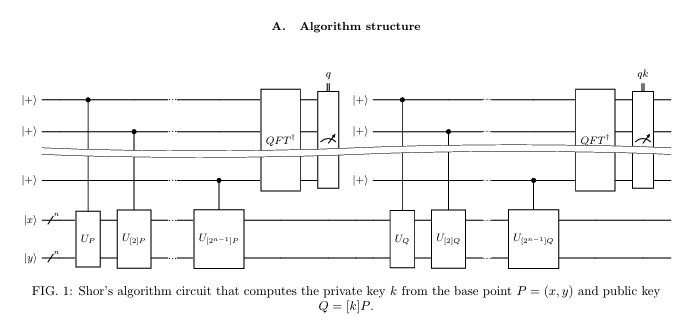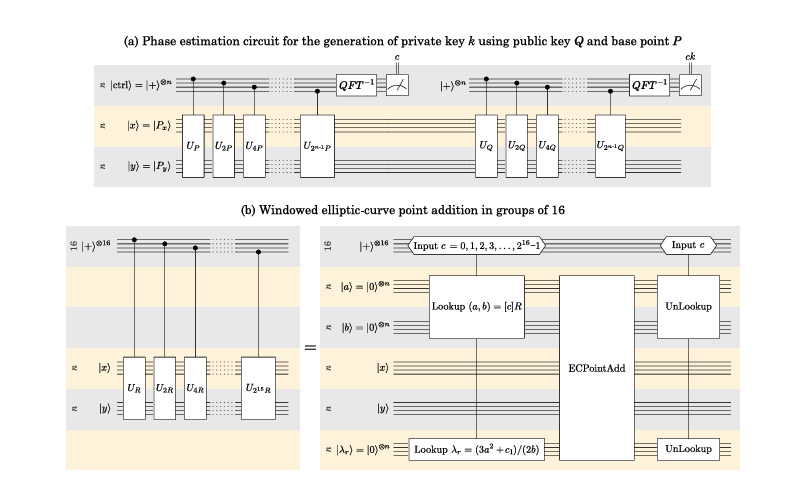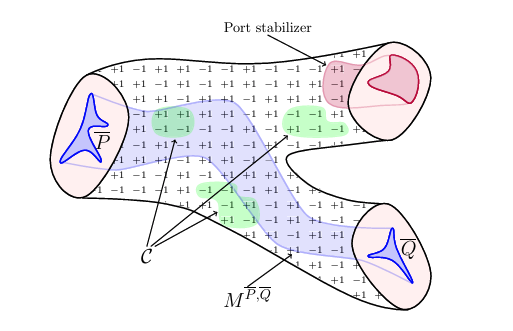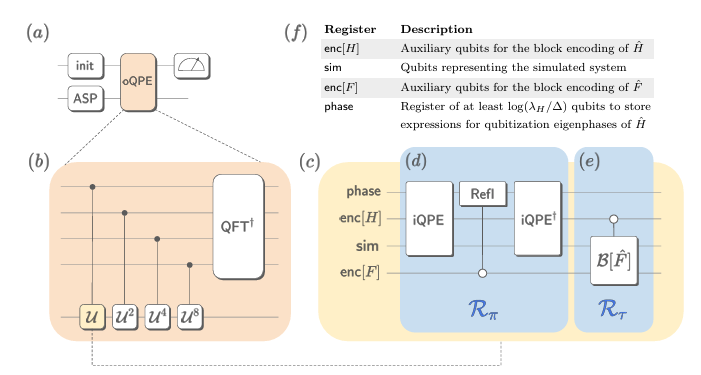
Simulating the Schwinger effect in 1+1 dimensions on a fault-tolerant quantum computer
Researchers from PsiQuantum have conducted a detailed analysis of quantum resource estimates (QREs) for studying the Schwinger effect (electron-positron pair production from background electric-field energy) in 1+1 dimensions. This was done by compiling two quantum-simulation algorithms for two relevant instances that were examined: (a) the quench of the electric field where the interaction is turned on at t=0 and electron-positron pairs start getting created, and (b) the scattering/splitting of an electron-positron particle pair that then travels through the lattice…

Faster Quantum Chemistry Simulations on a Quantum Computer with Improved Tensor Factorization and Active Volume Compilation
In this work, we combine several advances to electronic structure calculation for molecular systems, resulting in a 2-orders-of-magnitude speedup of estimated runtimes over prior-art algorithms run on comparable quantum devices…

Resource-optimized fault-tolerant simulation of the Fermi-Hubbard model and high-temperature superconductor models
Exploring low-cost applications is paramount to creating value in early fault-tolerant quantum computers. Here, we optimize both gate and qubit counts of recent algorithms for simulating the Fermi-Hubbard model…

Reducing quantum resources for observable estimation with window-assisted coherent QPE
Our latest research tackles one of quantum computing’s biggest challenges: making high-precision molecular simulations of observable estimation practical for future hardware.

Blocklets
PsiQuantum presents a new, practical approach to fault tolerant quantum computing. The new approach, one particularly suitable for the high connectivity of photonic quantum computers, manages to achieve large checks but with fixed (small) hardware, leading to significantly higher performance.

End-to-end framework for simulating the time evolution of a chemical reaction on a fault-tolerant quantum computer
Researchers from PsiQuantum and Stanford have developed a comprehensive state-of-the-art end-to-end framework for the simulation of real-time dynamics of chemical systems on a fault-tolerant quantum computer; this is of interest in modeling the dynamics of chemical reactions, such as those that involve catalysts.

Reducing the execution time for breaking elliptic-curve cryptography using Active Volume and photonic hardware
Researchers from PsiQuantum and the Hartree Centre have published the first physical resource estimate to execute a quantum algorithm for breaking Elliptic Curve Cryptography (ECC) over binary fields.


The cost of solving linear differential equations on a quantum computer: fast-forwarding to explicit resource counts
Simulating complex dynamical systems—like plasma behavior, fluid flow, or coupled oscillators—is one of the biggest computational challenges in science and engineering. Classical computers struggle with these problems due to the curse of dimensionality: as systems grow larger and more complex, the computational resources required scale exponentially.

Fault-Tolerant Quantum Algorithm for Symmetry-Adapted Perturbation Theory
Traditional methods can estimate total interaction energies, but breaking these down into components such as electrostatics, exchange, induction, and dispersion provides valuable insight for rational drug design. Symmetry-adapted perturbation theory (SAPT) is a well-established method for this type of energy decomposition, though it can be computationally demanding for strongly correlated molecules.
Our recent paper introduces the first quantum algorithm for calculating SAPT observables on a fault-tolerant quantum computer. By combining tensor factorizations and block-encodings, the method achieves Heisenberg-limited precision and provides concrete resource estimates for benchmark molecules.

Thinking inside the blocks: Fighting faults with a logical instruction set
How large does a useful quantum computer need to be?
This is an important but surprisingly hard question to answer.

A More Efficient Method for Breaking Elliptic Curve Cryptography (ECC) Using a Fault Tolerant Quantum Computer
Cracking cryptographic protocols is a well-known impact area for fault-tolerant quantum computing. Clearly it is important to estimate just when quantum computers will impact cryptography.

PsiQuantum Announces Breakthrough in Architectures for Error-Corrected QuantumComputing
We recently announced a new approach to vastly increasing the efficiency of running quantum algorithms. We call it the Active Volume Architecture…

A world-first scalable framework for decoding, capable of supporting PsiQuantum’s first generation of fault-tolerant quantum computers.
Over the past three decades significant reductions have been made to the cost of estimating ground-state energies of molecular Hamiltonians with quantum computers….

PsiQuantum and Boehringer Ingelheim: Fault-tolerant quantum computation of molecular observables
Over the past three decades significant reductions have been made to the cost of estimating ground-state energies of molecular Hamiltonians with quantum computers. However, comparatively little attention has been paid to estimating the expectation values of other observables with respect to said ground states, which is important for many industrial applications.

PsiQuantum and Mercedes-Benz: counting qubits for better batteries
The widespread adoption of electric vehicles rests on developing faster charging, longer lasting battery technology – the critical enabler for transitioning away from internal combustion engines. PsiQuantum has been working with Mercedes Benz to assess just how advanced a quantum computer must be to revolutionize Lithium-ion (Li-ion) battery design.

Demonstration of an all-optical quantum controlled-NOT gate
The promise of tremendous computational power, coupled with the development of robust error-correcting schemes, has fuelled extensive efforts to build a quantum computer.
Author: J. L. O'Brien, G. J. Pryde, A. G. White, T. C. Ralph & D. Branning, Nature volume 426, pages 264–267 - Published: Nov 20, 2003

Optical quantum computing
In 2001, all-optical quantum computing became feasible with the discovery that scalable quantum computing is possible using only single-photon sources, linear optical elements, and single-photon detectors.
Author: Jeremy O'Brien, Science Vol. 318, Issue 5856 - Published: Dec 07, 2007

Shor's quantum factoring algorithm on a photonic chip
Shor’s quantum factoring algorithm finds the prime factors of a large number exponentially faster than any other known method, a task that lies at the heart of modern information security, particularly on the Internet. This algorithm requires a quantum computer, a device that harnesses the massive parellism afforded by quantum superposition and entanglement of quantum bits (or qubits). We report the demonstration of a compiled version of Shor’s algorithm on an integrated waveguide silica-on-silicon chip that guides four single-photon qubits through the computation to factor 15.
Author: Politi et al. Science 04 Sep 2009, Vol. 325, Issue 5945, pp. 1221 - Published: Sep 04, 2009
All authors: Alberto Politi, Jonathan C. F. Matthews, Jeremy L. O'Brien

High-fidelity operation of quantum photonic circuits
We demonstrate photonic quantum circuits that operate at the stringent levels that will be required for future quantum information science and technology. These circuits are fabricated from silica-on-silicon waveguides forming directional couplers and interferometers.
Author: Laing et al. Appl. Phys. Lett. 97, 211109 - Published: Jun 17, 2010
All authors: Anthony Laing, Alberto Peruzzo, Alberto Politi, Maria Rodas Verde, Matthaeus Halder, Timothy C. Ralph, Mark G. Thompson, Jeremy L. O’Brien
